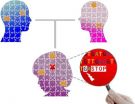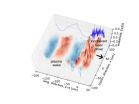(Press-News.org) This news release is available in French.
Listening to a conversation in the context of a cocktail party presents a great challenge for the auditory system. Without realizing it, one must extract, from a complex mixture of sound, the sound of a single voice to understand and track it. Researchers at Queen's University, lead by Dr. Ingrid Johnsrude, are studying how our brains meet that challenge, and allow us to distinguish specific voices in crowded, noisy and distracting environments. Her studies have revealed that the brain does not simply rely on the incoming sounds that reach the ear to understand and retain speech, but rather also relies on information from other senses and prior knowledge to facilitate comprehension. These results were presented at the 8th Annual Meeting of the Canadian Association for Neuroscience held in Montreal, Canada May 25 to 28th 2014.
Dr. Johnrude's studies exposed test subjects to degraded or clear speech in the presence or absence of distraction. By looking at activation of different brain regions while test subjects were exposed to different listening conditions, Dr. Johnsrude's research has revealed that the early processing of sound, which occurs in a brain region called the primary auditory cortex, depends on higher-level linguistic knowledge encoded in other regions of the brain.
Following a conversation in a noisy environment also requires one to disregard surrounding noises and distractions and specifically focus on a conversational partner. While clear speech was understood and remembered whether subjects were distracted or not by other tasks, attention was shown to be critically important to understand degraded speech.
What you hear and understand of a conversation is influenced by what you are used to hearing, so it will be easier to understand a familiar voice than that of a stranger. This was shown to be especially true for older adults, who were shown to have more difficulty understanding new voices in a cocktail party situation as they age, but did not show a decline in the ability to understand familiar voices in the same situation.
"We're all familiar with the glass half empty view of aging – that, as you get older, everything gets worse" says Dr. Johnsrude. "You need glasses, your memory goes, and it's harder to hear when you're conversing in a busy place like a restaurant or a party, where many people are talking at once. We wanted to investigate the glass-half full side of aging. One thing that older people have more of than younger people is experience. I study how the experience of older people, like their familiarity with the voice of their significant other, helps them compensate for age-related declines in other abilities."
Furthermore, Dr. Johnsrude was able to show that activation of certain brain regions, the higher-order speech sensitive cortex, could be viewed as a neural signature of effortful listening. Measuring the effort required to understand speech, using the techniques developed by Dr. Johnsrude, may provide a novel way to assess the efficacy and comfort of hearing protheses, and help researchers optimize the benefits obtained from these devices.INFORMATION:
About the Canadian Association for Neuroscience:
The Canadian Association for Neuroscience is the largest association dedicated to the promotion of all fields of neuroscience research in Canada. The association has been organizing a yearly annual meeting since 2007. Learn more about our meeting at: http://www.can-acn.org/meeting2014
Cocktail party neuroscience: Making sense of voices in a crowd
The role of prediction and attention in understanding of speech
2014-05-28
ELSE PRESS RELEASES FROM THIS DATE:
New research shows memory is a dynamic and interactive process
2014-05-28
This news release is available in French. Research presented by Morris Moscovitch, from the Rotman Research Institute at the University of Toronto, shows that memory is more dynamic and changeable than previously thought. Dr. Moscovich's results reveal that important interactions between the hippocampus and the neocortex, two regions of the brain, have different yet complementary roles in remembering places and events. These results highlight that different forms of memories exist in the brain, and that these are encoded in different, but interacting parts of the ...
Uncovering clues to the genetic cause of schizophrenia
2014-05-28
NEW YORK, NY (May 21, 2014) — The overall number and nature of mutations—rather than the presence of any single mutation—influences an individual's risk of developing schizophrenia, as well as its severity, according to a discovery by Columbia University Medical Center researchers published in the latest issue of Neuron. The findings could have important implications for the early detection and treatment of schizophrenia.
Maria Karayiorgou, MD, professor of psychiatry and Joseph Gogos, MD, PhD, professor of physiology and cellular biophysics and of neuroscience, and their ...
A path toward more powerful tabletop accelerators
2014-05-28
Making a tabletop particle accelerator just got easier. A new study shows that certain requirements for the lasers used in an emerging type of small-area particle accelerator can be significantly relaxed. Researchers hope the finding could bring about a new era of accelerators that would need just a few meters to bring particles to great speeds, rather than the many kilometers required of traditional accelerators. The research, from scientists at the U.S. Department of Energy's (DOE) Lawrence Berkeley National Laboratory (Berkeley Lab), is presented as the cover story in ...
PTSD treatment cost-effective when patients given choice
2014-05-28
A cost-analysis of post-traumatic stress disorder treatments shows that letting patients choose their course of treatment – either psychotherapy or medication – is less expensive than assigning a treatment and provides a higher quality of life for patients.
In a recent study, published in the Journal of Clinical Psychiatry, PTSD patients allowed to choose between therapies ended up costing about $1,622 less on average per patient per year compared with patients who were assigned treatment. Among patients not given a choice, treatment with prolonged exposure psychotherapy ...
Technology marketers should take consumer life-cycle into account: New Rotman study
2014-05-28
Toronto – If you want grandpa to start using the bank machine instead of standing in line for the teller, the best way to do it is to tell him to "Act now!" with a limited time offer for a banking card, shows new research.
A new study from the University of Toronto's Rotman School of Management suggests marketers should pay attention to where consumers are in their lifecycles when determining how to get them to adopt new technologies.
Marketers may have incorrectly assumed that older consumers avoid products such as debit or credit cards because they are technophobic ...
Supersonic spray delivers high quality graphene layer
2014-05-28
A simple, inexpensive spray method that deposits a graphene film can heal manufacturing defects and produce a high quality graphene layer on a range of substrates, report researchers at the University of Illinois at Chicago and Korea University.
Their study is available online in the journal Advanced Functional Materials.
Graphene, a two-dimensional wonder-material composed of a single layer of carbon atoms, is strong, transparent, and an excellent conductor of electricity. It has potential in a wide range of applications, such as reinforcing and lending electrical ...
NASA sees northern Indian Ocean System 92B's end
2014-05-28
The tropical low pressure area known as System 92B finally dissipated on the east central coast of India on May 27 after six days of struggling to develop. System 92B developed in the Bay of Bengal, Northern Indian Ocean basin on May 21. NASA's TRMM, Aqua and Suomi NPP satellites captured data on the low throughout the ups and downs it experienced until wind shear finally took its toll on the system.
NASA and the Japan Aerospace Exploration Agency's Tropical Rainfall Measuring Mission (TRMM) satellite passed over System 92B on May 19 and 20 and captured data on System ...
Lethal injection comes under new scrutiny after botched execution
2014-05-28
The botched execution in April of a man convicted of murder brought to the fore of national consciousness the precarious state of capital punishment. An article in Chemical & Engineering News (C&EN), the weekly news magazine of the American Chemical Society, details the history of lethal injection, what went wrong in April and how states are currently handling the practice, once deemed the most humane way to execute prisoners.
Jyllian Kemsley, a senior editor at C&EN, explains that the three-compound procedure prison officials use to carry out executions by lethal injection ...
Brazilian researchers find human menstrual blood-derived cells 'feed' embryonic stem cells
2014-05-28
Tampa, Fla. (May 28, 2014) – To be suitable for medical transplantation, one idea is that human embryonic stem cells (hESCs) need to remain "undifferentiated" i.e. they are not changing into other cell types. In determining the best way to culture hESCs so that they remain undifferentiated and also grow, proliferate and survive, researchers have used blood cell "feeder-layer" cultures using animal-derived feeder cells, often from mice (mouse embryonic fibroblasts [MEFs]). This approach has, however, been associated with a variety of contamination problems, including pathogen ...
Can Tai Chi slow the aging process?
2014-05-28
Putnam Valley, NY. (May 28, 2014) – Tai Chi, a traditional Chinese martial art and sport, has been found to be beneficial in raising the numbers of an important type of cell when three groups of young people were tested to discover the benefits of Tai Chi, brisk walking or no exercise. The group performing Tai Chi saw a rise in their cluster of differentiation 34 expressing (CD34+) cells, a stem cell important to a number of the body's functions and structures.
The study was published in issue 23(4/5) of Cell Transplantation and is freely available on-line at: http://www.ingentaconnect.com/content/cog/ct/2014/00000023/F0020004/art00020.
"To ...
LAST 30 PRESS RELEASES:
Drone sampling of whale breath reveals first evidence of potentially deadly virus in Arctic
Roman soldiers defending Hadrian’s Wall infected by parasites, study finds
Pinochet’s prisoners were tormented with music but still found solace in it, a new book reveals
Fertility remains high in rural Tanzania despite access to family planning
AI-assisted device can improve autism care access
Kinetic careers
Uncovering how parasitic plants avoid attacking themselves to improve crop resistance
Nanoparticle vaccine strategy could protect against Ebola and other deadly filoviruses
Study finds brain care score can predict risk of stroke across racial groups
Key lung immune cells can intensify allergic reactions
Do hormones explain why women experience more gut pain?
New materials conduct ions in solids as easily as in liquids
Breakthrough of the Year: Renewable energy begins to eclipse fossil fuel-based sources
LLM use is reshaping scientific enterprise by increasing output, reducing quality and more
Introducing LightGen, a chip for ultra-fast, ultra-efficient generative AI
Astronomers see fireworks from violent collisions around nearby star
ACC/AHA issue new guideline on managing congenital heart disease in adults
Cosmic crash caught on camera
Is talented youth nurtured the wrong way? New study shows: top performers develop differently than assumed
Ants: An untapped resource in the development of antibiotics?
Archaeologists use AI to create prehistoric video game
Mitochondria migrate toward the cell membrane in response to high glucose levels
Tiny viral switch offers hope against drug-resistant bacteria
Most parents aware of early peanut introduction guidelines, but confused about details
HPV vaccine can protect against severe lesions of the vulva and vagina
Virtual care provision and emergency department use among children and youth
Quadrivalent HPV vaccine and high-grade vulvovaginal lesions
Insights into dry eyes gained from stem cell-derived tear glands
Researchers identify 166 human pluripotent stem cell lines available for use in clinical applications
Europa Clipper instrument uniquely observed interstellar comet 3I/ATLAS
[Press-News.org] Cocktail party neuroscience: Making sense of voices in a crowdThe role of prediction and attention in understanding of speech




